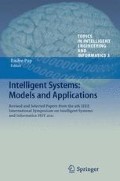Abstract
In this paper a new mathematical model of basic planar imprecise geometric objects (fuzzy line, fuzzy triangle and fuzzy circle) are introduced. Also, basic measurement functions (distance between fuzzy point and fuzzy line, fuzzy point and fuzzy triangle, two fuzzy lines and two fuzzy triangles) as well as spatial operation (linear combination of two fuzzy points) and main spatial relations (coincidence, between and collinear)is proposed. Results obtained with our model can be used in various applications such as image analysis (imprecise feature extraction), GIS (imprecise spatial object modeling), robotics (environment models). Imprecise point objects are modeled as a union of linear combinations of fuzzy points in linear fuzzy space. However, it is proved that fuzzy line could be represented only by two and fuzzy triangle with three fuzzy points.
Access this chapter
Tax calculation will be finalised at checkout
Purchases are for personal use only
Preview
Unable to display preview. Download preview PDF.
References
Obradović, D., Konjovic, Z., Pap, E., Ralević, N.M.: The maximal distance between imprecise point objects. Fuzzy Sets and Systems 170(1), 76–94 (2011)
Guibas, L., Salesin, D., Stolfi, J.: Epsilon geometry: building robust algorithms from imprecise computations. In: Proceedings of the Fifth Annual Symposium on Computational Geometry, New York, NY, USA, pp. 208–217 (1989)
Löffler, M., van Kreveld, M.: Geometry with Imprecise Lines. In: 24th European Workshop on Computational Geometry (2008)
Löffler, M.: Data Imprecision in Computational Geometry. PhD Thesis. Utrecht University, Utrecht (2009)
Löffler, M., van Kreveld, M.: Largest and Smallest Convex Hulls for Imprecise Points. Algorithmica 56(2), 235–269 (2008)
Yang, K., SamGe, S., He, H.: Robust line detection using two-orthogonal direction image scanning. Computer Vision and Image Understanding 115(8), 1207–1222 (2011)
Kiryati, N., Eldar, Y., Bruckstein, A.M.: A probabilistic Hough transform. Pattern Recognition 24(4), 303–316 (1991)
Stephens, R.S.: Probabilistic approach to the Hough transform. Image and Vision Computing 9(1), 66–71 (1991)
Galambos, C., Matas, J., Kittler, J.: Progressive probabilistic Hough transform for line detection. In: IEEE Computer Society Conference on Computer Vision and Pattern Recognition, vol. 1 (1999)
Matas, J., Galambos, C., Kittler, J.: Robust Detection of Lines Using the Progressive Probabilistic Hough Transform. Computer Vision and Image Understanding 78(1), 119–137 (2000)
Galambos, C., Kittler, J., Matas, J.: Using gradient information to enhance the progressive probabilistic Hough transform. In: Proceedings 15th International Conference on Pattern Recognition, ICPR 2000, Barcelona, Spain, pp. 560–563 (2000)
Schneider, M.: Fuzzy topological predicates, their properties, and their integration into query languages. In: Proceedings of the 9th ACM International Symposium on Advances in Geographic Information Systems, pp. 9–14 (2001)
Rosenfeld, A.: The fuzzy geometry of image subsets. Pattern Recognition Letters 2(5), 311–317 (1984)
Schneider, M.: Design and implementation of finite resolution crisp and fuzzy spatial objects. Data Knowl. Eng. 44, 81–108 (2003)
Buckley, J.J., Eslami, E.: Fuzzy plane geometry I: Points and lines. Fuzzy Sets and Systems 86(2), 179–187 (1997)
Schneider, M.: Spatial Data Types for Database Systems: Finite Resolution Geometry for Geographic Information Systems. Springer (1997)
Obradović, D., Konjović, Z., Pap, E.: Extending PostGIS by imprecise point objects. In: IEEE 8th International Symposium on Intelligent Systems and Informatics, Subotica, Serbia, pp. 23–28 (2010)
Verstraete, J., Tré, G., Caluwe, R., Hallez, A.: Field based methods for the modeling of fuzzy spatial data. Fuzzy Modeling with Spatial Information for Geographic Problems, 41–69 (2005)
Dudaand, R.O., Hart, P.E.: Use of the Hough transformation to detect lines and curves in pictures. Commun. ACM 15(1), 11–15 (1972)
Hadžić, O., Pap, E.: Fixed point theory in probabilistic metric spaces. KluwerAcademic Publishers, Dordecht (2001)
Obradović, D., Konjović, Z., Pap, E., Rudas, I.J.: Linear Fuzzy Space Based Road Lane Model and Detection. Knowledge-Based Systems (to appear)
Author information
Authors and Affiliations
Corresponding author
Editor information
Editors and Affiliations
Rights and permissions
Copyright information
© 2013 Springer-Verlag Berlin Heidelberg
About this chapter
Cite this chapter
Obradović, D., Konjović, Z., Pap, E., Rudas, I.J. (2013). Fuzzy Geometry in Linear Fuzzy Space. In: Pap, E. (eds) Intelligent Systems: Models and Applications. Topics in Intelligent Engineering and Informatics, vol 3. Springer, Berlin, Heidelberg. https://doi.org/10.1007/978-3-642-33959-2_8
Download citation
DOI: https://doi.org/10.1007/978-3-642-33959-2_8
Publisher Name: Springer, Berlin, Heidelberg
Print ISBN: 978-3-642-33958-5
Online ISBN: 978-3-642-33959-2
eBook Packages: EngineeringEngineering (R0)

